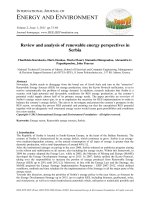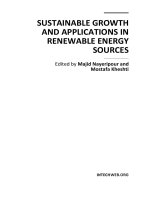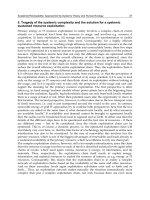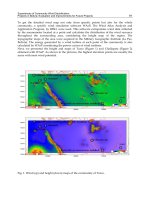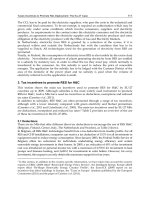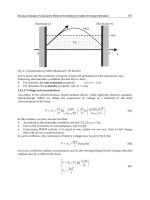Awareness and willingness on renewable energy utilization toward sustainable development among post secondary students from myint mo education foundation (mef), myanmar
Bạn đang xem bản rút gọn của tài liệu. Xem và tải ngay bản đầy đủ của tài liệu tại đây (3.08 MB, 95 trang )
VIETNAM NATIONAL UNIVERSITY, HANOI
VIETNAM JAPAN UNIVERSITY
NAW KHU KHU SAN
AWARENESS AND WILLINGNESS ON
RENEWABLE ENERGY UTILIZATION
TOWARD SUSTAINABLE DEVELOPMENT
AMONG POST-SECONDARY STUDENTS
FROM MYINT-MO EDUCATION
FOUNDATION (MEF), MYANMAR
MASTER’S THESIS
VIETNAM NATIONAL UNIVERSITY, HANOI
VIETNAM JAPAN UNIVERSITY
NAW KHU KHU SANN
AWARENESS AND WILLINGNESS ON
RENEWABLE ENERGY UTILIZATION
TOWARD SUSTAINABLE DEVELOPMENT
AMONG POST-SECONDARY STUDENTS
FROM MYINT-MO EDUCATION
FOUNDATION (MEF), MYANMAR
MAJOR: CLIMATE CHANGE AND DEVELOPMENT
CODE: 8900201.02QTD
RESEARCH SUPERVISOR:
Prof. SAKAMOTO MEGUMI
Hanoi, 2021
ACKNOWLEDGEMENTS
First and above all, I would like to thank the Almighty GOD for letting me through all
the difficulties, for his constant love, countless blessings and granting me the
necessary wisdom to accomplish successfully.
I would like to express my deep thanks to my Scholarship Organization, JapanASEAN Integration Fund (JAIF-VJU) for enabling opportunity to study for a two-year
master program specializes in Master of Climate change and development (MCCD).
I would like to thank to my Vietnam Japan University, VJU especially to Master of
Climate change and development (MCCD) program and all members of VJU for
allowing me to study for my master‟s degree and for all the supporting.
I would like to express my greatest gratitude to my supervisor, Prof. Dr. Megumi
Sakamoto for accepting me to be my supervisor and for his valuable contributions and
instruction in many different ways at every stage of my master thesis. Even though all
the process were going via online, he was a great mentor always ready to help me and
always encourage me to try hard on my study. Without his details guidance and
support, this thesis would not have accomplished. I can‟t say thank you enough for his
extremely patience encouragement, wise advice, consistent support and guidance
especially during the seemingly challenging times.
I would like thank to Prof. Dr. Myint Thida for supporting and giving motivation
during academic periods and always giving advice for studying even in busy time.
Moreover, I would like to thank to all of the teachers and students from Myint-Mo
Education Foundation (MEF) for providing all the necessary information for my
master thesis.
I would like to express my special thanks to my family for their encouragement in
numerous ways and spiritual support in all aspects of my whole life. Finally, I would
like to thank all of my MCCD friends who are always helping each other throughout
academic years. All in all, I am really thankful to all the people who had been
supported me during my whole academic years.
TABLE OF CONTENTS
LIST OF TABLES .......................................................................................................................... i
LIST OF FIGURES ....................................................................................................................... ii
LIST OF ABBREVIATIONS ..................................................................................................... iii
CHAPTER 1: INTRODUCTION ................................................................................................ 1
1.1. The necessity of the research ................................................................................1
1.2. The research questions and objectives ..................................................................3
1.2.1. Research questions .........................................................................................3
1.3. Research hypotheses .............................................................................................4
1.4. Objects and scope .................................................................................................5
1.4.1. Research objects.............................................................................................5
1.4.2. Scope ..............................................................................................................5
1.5. Research framework .............................................................................................7
1.6. Terms and definition .............................................................................................8
CHAPTER 2: LITERATURE REVIEW .................................................................................... 9
2.1. Sustainable development ......................................................................................9
2.2. Renewable energy ...............................................................................................10
2.3. Awareness and willingness to use RE ................................................................11
2.4. Myanmar's educational system and MEF ...........................................................15
2.5. International cooperation to make national electrification plans for Myanmar .21
2.5.1. Myanmar national electrification plan 2014 (MNEP) (World Bank) ..........22
2.5.2. Myanmar national electrification program (NEP) 2014 CASTALIA ..........23
2.5.3. National electric master plan(NEMP)2014 JICA ..................................24
2.5.4. Power sector development in Myanmar2015, (PSDM) ADB ......................25
2.6. Myanmar climate change master plan (MCCMP) (2018-2030) .........................26
CHAPTER 3: RESEARCH METHODOLOGY ..................................................................... 28
3.1. Research design ..................................................................................................28
3.2. Population ...........................................................................................................28
3.3. Research instrument ............................................................................................28
3.4. Data collection ....................................................................................................29
3.5. Data analysis .......................................................................................................30
3.6. Validity and reliability ........................................................................................32
CHAPTER 4: RESULTS AND DISCUSSION ....................................................................... 34
4.1 Questionnaire response rate .................................................................................34
4.2. Research finding .................................................................................................34
4.2.1. General characteristics of the respondents (teachers) ................................34
4.2.2. School Attribution ........................................................................................36
4.2.3 Accessing the needs to introduce CC, RE and SD ........................................38
4.2.4. General characteristics of the respondents (students).................................42
4.2.5. Accessing the students’ knowledge related to renewable energy ................43
4.2.6. Accessing the students’ sources of information getting about RE ...............45
4.2.7 Accessing the level of students’ awareness and willingness on RE utilization
toward SD...............................................................................................................47
4.3. Main finding .......................................................................................................50
4.3.1. The means and standard deviation results of students’ awareness and
willingness ..............................................................................................................50
4.3.2. The T- test analysis results of significant difference between females and
males students’ awareness .....................................................................................50
4.3.3. The T- test analysis results of significant difference between females and
males students’ willingness ....................................................................................51
4.3.4. The one way ANOVA results of significant effect of sources on the students’
awareness ...............................................................................................................52
4.3.5. The Pearson correlation results of significant relation between students’
awareness and willingness .....................................................................................52
4.4 Discussion ............................................................................................................53
4.5 SWOT analysis on student‟s awareness and willingness on Renewable Energy,
Climate Change mitigation and Sustainable development goals in Myint-Mo
Education Foundation academies ..............................................................................58
CHAPTER 5: CONCLUSIONS AND RECOMMENDATIONS ........................................ 59
5.1 Conclusions ..........................................................................................................59
5.2. Recommendations ...............................................................................................60
5.2.1. Recommendations for National Governments and Local Governments ......60
5.2.2. Recommendations for Stakeholders .............................................................61
5.2.3. Recommendations for Curriculum Developers ............................................61
5.2.4. Recommendations for MEF Academies .......................................................61
5.2.5. Recommendations for Further Researchers ................................................62
REFERENCES............................................................................................................................. 63
APPENDICES.............................................................................................................................. 70
LIST OF TABLES
Table 2. 1 : Number of Schools, Teachers and Students in the 2015 - 2016 Academic
Year ...............................................................................................................................15
Table 2. 2 : Enrolment rates in ethnic schools .............................................................19
Table 3. 1 : Data collection process...............................................................................29
Table 3. 2 : Data analysis method .................................................................................30
Table 4. 1: Demographic Profile of the Respondents (Teachers) .................................34
Table 4. 2 : Subjects of school teaching related to CC, RE and SD .............................36
Table 4. 3 : Information getting about renewable energy .............................................36
Table 4. 4 : Information about the factors that mainly needed for teacher ...................37
Table 4. 5 : Classroom materials needed for the students .............................................37
Table 4. 6 : Percentage of current working community needed to introduce RE .........38
Table 4. 7 : Percentage of sectors mainly needed for promoting RE in the region ......38
Table 4. 8 : The sectors needed to improve for students learning in each academy .....39
Table 4. 9 : Teachers‟ requirement to enhance RE education in classrooms ................39
Table 4. 10 : Feeling about the current program of the academy to teach RE and SD .41
Table 4. 11 : Teachers‟ self-assessment of the knowledge on RE,CC and SD .............42
Table 4. 12 : Demographic Profile of the Respondents (Students) ...............................42
Table 4. 13 : Renewable energy device students have actually seen before .................43
Table 4. 14 : Information getting about renewable energy ...........................................46
Table 4. 15 : The level of students‟ awareness on RE utilization toward SD ..............47
Table 4. 16 : The level of students‟ awareness on RE utilization toward SD ...............48
Table 4. 17 : The attitude of students‟ willingness on RE utilization toward SD .........49
Table 4. 18 : The students‟ means and standard deviation score ..................................50
Table 4. 19 : Students‟ awareness T-test analysis .........................................................51
Table 4. 20 : Students‟ willingness T-test analysis .......................................................51
Table 4. 21 : One way ANOVA analysis results of the students ..................................52
Table 4. 22 : Pearson Correlation results of the students ..............................................52
i
LIST OF FIGURES
Figure 1. 1: Map of the MEF academies location ...........................................................6
Figure 1. 2 : Research Framework ..................................................................................7
Figure 2. 1 : Major stages of awareness development process .....................................12
Figure 2. 2 : Technology Acceptance Model. ...............................................................14
Figure 2. 3 : The Old and New Basic Education Systems ............................................18
Figure 2. 4 : International Cooperation to make National Electrification Plans for
Myanmar ........................................................................................................................22
Figure 4. 1 : Percentage of the students‟ familiarity with the concept of RE, CC and
SD ..................................................................................................................................43
Figure 4. 2 : Percentage of Students willingness to study about renewable energy .....44
Figure 4. 3 : The students‟ respond on the electricity of Myanmar generated by RE ..45
Figure 4. 4 : The students‟ respond on accessing the education about RE in the class 46
Figure 4. 5 : The factors mainly needed to study about RE in the MEF academies .....46
Figure 4. 6: The quality of education in the respondents academies‟ on RE, CC and SD
.......................................................................................................................................47
Figure 4. 7: Summary of SWOT Analysis ....................................................................58
ii
LIST OF ABBREVIATIONS
ADB
CC
CMA
EGG
GoM
JICA
KG
LUA
M/P
MCCMP
MEF
MOEP
MSDP
NEMC
NEMP
NEP
NGOs
PSDM
PTA
RE(S)
SPSS
VA
Asia Development Bank
Climate Change
Cherry Myay Academy
Education Gathering Group
Myanmar Government
Japan International Cooperation Agency
Kindergarten
Level Up Academy
Master Plan
Myanmar Climate Change Master Plan
Myint-Mo Education Foundation
Ministry of Electric Power
Myanmar Sustainable Development Plan
National Energy Management Committee
Myanmar National Electrification Plan
National Electrification Program
Non-governmental Organizations
Power Sector Development in Myanmar
Pinnya Tagar Academy
Renewable Energy (Sources)
Statistical Package for the Social Sciences
Victoria Academy
iii
CHAPTER 1: INTRODUCTION
1.1. The necessity of the research
Renewable energy (RE) resources often refer as clean source of energy which
cannot be depleted easily. It is naturally replenished which can provide enough energy
sources for long term period (Renewable Energy | National Geographic Society, n.d.).
Nowadays, the demand of energy consumption is very high which is widely used by
non-renewable energy sources and it can harm to our planet day to day by emitting
greenhouse gases such as CO2 gas. According to National Geographic Society, USA
still depends on non-renewable energy sources (Renewable Resources | National
Geographic Society, n.d.). Therefore, it needs to develop sustainable ways for the
future and renewable energy is one of the energy sources that can bring sustainable
development which could help to achieve to the climate target of Paris Agreement.
There are so many renewable energy sources which include Wind, Solar and
Hydroelectric energy are three main sources among them. According to the Norway
pioneering sustainability, the electricity of Norway has been used from renewable
sources since the end of the 1800s (Renewable Energy Production in Norway Regjeringen.No, n.d.). The Philippines and Indonesia are the second and third largest
geothermal power generators, respectively, Japan and China were the top solar PV
markets in 2014. In Myanmar, the investment on renewable energy is still slow but
Myanmar Sustainable Development Plan (MSDP) (2018-2010) highlights increasing
renewable energy generation as one of its Strategies and Action Plans. It is therefore
crucial to investigate the students‟ awareness on renewable energy towards sustainable
development to be able to positively influence and strengthen in the areas of energy
conscious generations.
It is obvious that natural resources are gradually running out due to excessive
extract using for daily human commodity. People are more self-centered for the sake
of their current luxury and nothing can stop human cupidity on the other hand. Natural
resources are extracted without limitation either legally or illegally around the world.
Besides, there is vulnerable treatment or handling for the global suffering from
unstoppable devastation although respective organizations of environmental
1
preservations are striving to conserve our planet accordingly. It cannot deny that it has
been quite late to save our planet efficiently but this is only the right time to begin
effective preservation as much as we can afford. If not, it will be completely running
out and there will be only a stuck for our future generation. Running out of resources
can affect many matters of people. Climate change is one of the obvious effects, which
is getting worse as long as the natural resources is coming to an end because running
out of resources is directly proportional to rate of climate change. Climate change is a
big concern to handle for every country around the world. Currently, disasters like
global warming, drought and over-flooding due to climate change is occurring in each
part of the earth. Consequently, numbers of people are suffering from natural disasters
and struggling to make a living. Furthermore, crisis over different industries and aspect
is happening to lead people on the state of distress.
Climate change is manifest in the country with plenty of natural extract
especially in the eastern country. The resource curse is that countries with an
abundance of natural resources tend to have less economic growth, less democracy,
and worse development outcomes than countries with fewer natural resources. To be
more specific, most Southeast Asia countries are effective example of confronting
resource curse. Myanmar that is one of the Southeast Asia countries has natural
resources including oil and gas, various minerals, precious stones and gems, timber
and forest products, hydropower potential, etc. Large amount of country‟s revenue is
currently dependent on such natural extracts. To date, there has been a very low level
of systematic exploration of Myanmar‟s natural resources due to lack of modern
survey techniques (Rainer Einzenberger | Heinrich-Böll-Stiftung, n.d.).
One of the strategies and action plans in MSDP is to increase renewable energy
generation. Hence, practice of using renewable energy is a vital sector to boost as a
highly recommend even though Myanmar is rich of natural extract. As long as the
natural extract like forest and mountains to maintain the environment is gone, climate
change like global warming, ice melting, water rising, flooding may occur
consequently. Next, it is inevitable that our future generation is going to suffer from
such severe crisis although it is acceptable that people can afford to make a living
without any natural resources.
Since it is aware of the consequences, limited
2
extracting resources is crucial to conduct accordingly. Substitution of using renewable
energy is a significant resolution to proceed in order to limit the extraction of nonrenewable energy. It is not easy to utilize renewable energy for Myanmar because it
needs high-tech to operate renewable energy effectively. However, basic change of our
daily routine can also contribute to increase using renewable energy. For instance,
setting up and using solar panel is also a positive transition of using renewable energy
because solar energy is one of the inexhaustible natural energy. On the other hand, the
mindset and deed of everybody over using renewable energy is also very important.
Contribution of each person towards climate change is fundamental to make a move
forward constructive change.
Myint-Mo Education Foundation (MEF) is a non-profit organization based in
Myanmar without funding support from government. There are five academies under
the MEF and each academy is situated different states in Myanmar. All academies are
delivering same curriculum which includes various development subjects. Among
them, Environment topic is contained in the Social Science subjects. Each of the
academies is also initiating environmental activities normally with the conscious of
environmental conservation aspect. Throughout five academies, some alumni are
working for environment as an environmentalist actively. However, it is still weak at
consideration and contribution for environmental aspect especially for climate change.
Besides, consideration of renewable energy is still aside of their concept. Therefore,
this study is considering to do research about the willingness and awareness of
students from Myint-Mo Education Foundation (MEF) in Myanmar over the
renewable energy towards sustainable development. Eventually, this research is
expected to deliver helpful recommendation for MEF to consider climate change
mitigation for the sustainable development.
1.2. The research questions and objectives
1.2.1. Research questions
To guide the study, the following research questions are raised:
1) What is the level of awareness and willingness of the students on renewable
energy utilization in regard to sustainable development?
3
2) Is there any relation between awareness and willingness of the students on
renewable energy utilization in regard to sustainable development?
3) What is the requirements of the current situation to convey effective message
to the schools and leaders for sustainable development?
4) Which factors of the schools need to improve in order to promote effective
renewable energy awareness and willingness of the students?
1.2.2. Objectives
The purpose of this study is to explore the awareness and willingness of postsecondary students from Myint-Mo Education Foundation (MEF) on renewable
energy which will get a good outlook on the impact of climate change mitigation
towards sustainable development. The specific objectives of the study are:
1) To investigate the willingness and awareness of the post-secondary students
on renewable energy utilization toward sustainable development
2) To investigate the relation between students‟ awareness and willingness on
renewable energy utilization toward sustainable development
3) To investigate the requirements of the current situation to convey effective
message to the schools and leaders for sustainable development
4) To provide recommendations to the schools to promote effective renewable
energy awareness of the students
In order to achieve the objectives of the research, the tasks will be included
literature review, data analysis, assessing the present of MEF students‟ awareness
and willingness on renewable energy utilization toward sustainable development
and providing strong recommendation in order to achieve sustainable development.
1.3. Research hypotheses
1) There is a significant difference in awareness of renewable energy utilization
toward sustainable development between male and female students.
2) There is a significant difference in willingness of renewable energy utilization
toward sustainable development between male and female students.
3) There is a significant effect of sources of information on the awareness of
renewable energy utilization toward sustainable development of the students.
4
4) There is a significant relation between awareness and willingness of the
students on renewable energy utilization toward sustainable development.
5) Education on Renewable energy has been organized in all schools but still
need to improve school facilities, human resources and teaching equipment.
6) Education on renewable energy need to promote nationwide and still need so
many supports from differences sectors such as government sectors, nongovernmental organizations (NGOs), etc...to provide funding, quality education
on renewable energy.
1.4. Objects and scope
1.4.1. Research objects
Activities and methods on the awareness and willingness on renewable
energy utilization toward sustainable development in post-secondary students from
Myint-Mo
Education
Foundation
(MEF),
Myanmar.
1.4.2. Scope
This study was focused on the awareness and willingness on renewable
energy towards sustainable development among post-secondary students from
Myint-Mo Education Foundation (MEF). The study was conducted in five
Academies of MEF and the target area is located in geographically different parts of
Myanmar which are Karen State, Kayah State, Kachin State, Shan State and Chin
State.
5
Figure 1. 1: Map of the MEF academies location
Adapted from : (Myanmar.Png (270×599), 2013)
6
1.5. Research framework
The research objectives of this study was to investigates the students‟ awareness
and willingness on renewable energy utilizing in terms of sustainable development. This
study, reveals the importance of students‟ awareness and willingness on renewable
energy utilizing in terms of sustainable development.
The study of the research framework were provided in the following figure 1.2.
Figure 1. 2 : Research Framework
7
1.6. Terms and definition
Renewable energy: Renewable energy is energy from sources that are naturally
replenishing but flow-limited; renewable resources are virtually inexhaustible in duration
but limited in the amount of energy that is available per unit of time. Renewable energy
resources include biomass, hydro, geothermal, solar, wind, ocean thermal, wave action,
and tidal action (eia, 2020).
Climate Change: Climate change is a long-term shift in global or regional climate
patterns. Often climate change refers specifically to the rise in global temperatures from
the mid-20th century to present (National Geographic, 1996).
A change of climate that is attributed directly or indirectly to human activity that
alters the composition of the global atmosphere and that is in addition to natural climate
variability observed over comparable time periods (UNFCCC, 2011).
Sustainable Development : Development that meets the needs of the present without
compromising the ability of future generations to meet their own needs (United Nations,
1987).
Awareness: Awareness in general means, knowledgeable being conscious;
cognizant, informed alert. Awareness is the state or ability to perceive, to feel, or to be
conscious of events, objects, or sensory patterns (Gafoor, 2012a).
The quality or state of being aware, knowledge and understanding that something
is happening or exists (Merriam Webster, 1839).
Willingness : The quality or state of being prepared to do something; readiness
(Oxford, 2021).
8
CHAPTER 2: LITERATURE REVIEW
2.1. Sustainable development
Due to the rapid advancement of science and technology, the international
community is currently confronted with a variety of global issues. Sustainable
development challenges have recently gotten a lot of attention from the public and
governments as environmental difficulties in many nations across the world.
Sustainable development is defined as keeping the quantity of resources consumed
by society for today's requirements at a level that does not deprive future generations of
those resources. In other words, sustainable development is defined as development that
meets current needs without compromising future generations' ability to meet their own
(Hassan & Rahman, 2011).
Sustainable development, according to this definition, has three dimensions:
economic, social, and environmental. As a result, it has become important to meet the
ever-increasing energy demand in order to accomplish sustainable development; in other
words, to raise individual living standards, actualize societal production, and reduce
pollution of the resources employed in these processes (Ozturk, Acaravci, 2011).
The United Nations has stressed the steps countries should take by 2030 for
sustainable development by identifying 17 Sustainable Development Goals (SDGs). A
substantial relationship between the usage of renewable energy sources and sustainable
development has also emerged. Everyone should have access to inexpensive, reliable,
contemporary, and sustainable energy, according to the seventh goal. The relevance of
renewable energy for long-term growth has been emphasized in this regard (Guney,
2019a). UNESCO's efforts to promote the right to education and support the
accomplishment of the Sustainable Development Goals are intimately tied to gender
equality (SDGs). SDG 4 aims to "Ensure inclusive and equitable quality education and
promote lifelong learning opportunities for everyone," while SDG 5 wants to "Achieve
gender equality and empower all women and girls" through the Education 2030
Framework for Action (Education and Gender Equality, 2021).
9
For the sustainable development, the environmental education is also important.
Environmental education has been integrated into the educational system from
elementary school to tertiary level to achieve success in sustainable development.
Environmental education aims to promote people knowledg related to environmental
issues, as well as awareness of how to solve environmental problems and motivated
people to work toward solutions (Stapp, 1969).
2.2. Renewable energy
Renewable energy is certainly necessary for a sustainable society in which
individuals and industry can profit and prosper while natural resources are replenished at
a reasonable rate.
Renewable energy is defined as energy derived from natural sources such as
sunshine, wind, rain, and tides. There are six basic types of renewable energy, according
to the website renewables guide: wind, solar, biomass, geothermal, hydropower, and
biofuels. To summarize, a variety of renewable energy sources can be employed to
replace fossil fuels. Solar, wind, and biofuel are some of the most widely used renewable
energy sources. Renewable energy accounts for about 16 percent of worldwide final
energy consumption, with traditional biomass accounting for 10% and hydroelectricity
accounting for 3.4 percent. Another 3% came from emerging renewables (small hydro,
modern biomass, wind, solar, and biofuels), which are fast expanding (Global Status
Report, 2011).
The utilization of renewable energy resources, such as solid-state lighting instead
of traditional lighting technologies, can become an effective solution to many local
energy problems in the context of modern environmental and climatic difficulties
(Adhikari et al., 2019).
Renewable energy technology can also help provide energy for cooking, space
heating, and lighting in an indirect way. By giving electricity to schools, renewable
energy may also help with education. Renewable energy initiatives in many developing
nations have shown that renewable energy may directly contribute to improving people's
lives by providing the energy required to start businesses and create jobs (Alhayali et al.,
2017a). In Bangladesh, the use of renewable energy in rural and inaccessible places could
10
improve access to electricity and thereby raise people's living and social standards
(Anwarul Islam & Salma, 2016).
The utilization of RE in society has positive impact on the community as above
mentioned. In order to bring more healthy society in using energy, it is important to
promote the knowledge related to the renewable energy in the education sector too. By
promoting RE education, it will lead to sustainable development to the society.
2.3. Awareness and willingness to use RE
Awareness
Awareness is an important feature of human activity since it influences human
behavior and gestures. According to (Gafoor, 2012a), awareness is the state or ability to
notice, experience, or be aware of an object or pattern. Awareness can be used to
determine a person's impression of how they feel or comprehend certain concepts.
Measures of awareness are commonly classified into three categories: scales, tests,
and questionnaires. The goal of awareness measurement is to find out what respondents
know and don't know. As a result, anytime a measure of awareness is being developed,
following the procedures outlined below will aid in better clarifying the nature of the
construct in question and operationalizing it. 1) Determine the sort of awareness 2)
Defining the domain's nature 3) Choosing a natural population 4) Identifying the
measure's goal 5) Defining the domain and creating things within it 6) Editing and
analyzing items, and 7) Demonstrating Reliability and Validity (Gafoor, 2012b).
According to Redzuan 2001, knowledge, perceptions, and practices are the three
basic areas of awareness. As a result, knowledge can be gained through observing,
hearing, and media that are readily available. The perception conveying information
about ourselves and our community. Individuals' perception perceptio will provide
something useful, such as a method or suggestions. The act is committed by an individual
or a community to address and decrease the consequences of malpractice in terms of
practice. As a result, the combination of components of knowledge, attitudes, and
practices will inspire and teach individuals to respond positively to a certain object,
particularly energy efficiency actions. As a result, this combination is critical to the
success of energy efficiency initiatives (Ibrahim, n.d.).
11
Figure 2. 1: Major stages of awareness development process
Source: (Choong et al., 2006)
One of the research identified three important stages in the development of
awareness (Figure 2.1). The first stage (input) is the environmental stage, in which
external stimuli serve as the major input. According to the principle of learning, a
person's behavior will change as a result of his interactions with the environment. The
second step is the mental one (process). Perception and cognition are necessary in this
situation for handling, selecting, and understanding information. The third stage (output)
is the behavioural stage, in which all of the data received is mirrored in the receiver's
behavior (Choong et al., 2006).
According to (Wong, 1997), awareness is the seed for tomorrow's changes, hence
raising energy awareness is the first stage in a behavioral approach to energy
conservation . However, one of the research have revealed that society is under-informed
regarding the utilization of renewable energy in energy production (Aslanidou &
Menexes, 2008).
The process of producing consciousness would necessitate a re-examination of the
learning-awareness link. Learning is the process of mastering a specific ability, such as
reading, typing, playing a game, or even walking and talking (in early human stages)
(Wai et al., 2006). In one study, it mentioned that raising employee awareness is one of
the most effective ways to motivate them to conserve energy (Turner, 2001).
Raising the educational level of youth and increasing their environmental
consciousness will thus aid in the development of responsible future energy consumers.
Not only to the youth but also teacher education in the area of renewable energy is
critical in this setting. Teachers with sufficient knowledge of renewable energy will assist
12
students in gaining accurate information and values related to this issue of understanding
the benefits of renewable energy to society and the environment (Liarakou, Gavrilakis,
Flouri, 2009).
Therefore, it is necessary for implementing energy education at all levels of
education, including high school, university, and other academic institutions (Halder,
2011). By enhancing the energy education in education sectors, it will promote the
knowledge both to teachers and students. If not, the energy educational knowledge will
be still limited. Knowledge is described as awareness, and lack of knowledge is defined
as a lack of awareness (Wai et al., 2006).
Willingness
Willingness is a psychological state that shows an individual's willingness to
engage in the behavior when acceptable circumstances arise (Matear, 2014). The vast
bulk of extant research focuses on either public approval or willingness to pay for
renewable energy. However, people's willingness to use renewable energy and the factors
that influence that willingness are rapidly becoming recognized (Altuntas, Turan, 2018).
Regarding to the willingness on using renewable energy, one of the study
mentioned about the Technology Acceptance Model. The modified version of the
technology acceptance model (Figure 2.2). Users embrace new technology based on their
perceptions of how easy it is to use and how valuable it is, according to the model.
Individuals' perceptions of the benefits that a specific technology will provide them are
explained by perceived utility (e.g. improve their standard of living, be less harmful to
their health, environmentally friendly, etc.). Other factors such as household
characteristics (e.g., age, income, level of education, gender, expenditure, etc. ),
availability of renewable energy alternatives, accessibility of energy and associated
accessories, awareness of energy and its benefits, government policies, to name a few, all
influence households' and the general public's attitudes toward renewable energy
(Adjakloe et al., 2020).
The Technology Acceptance Model describes human attitudes toward using
technology as a mediating variable between people's intentions to patronize energy and
their perceptions of its ease of use and utility. However, the effect of perceived ease of
13
use, perceived usefulness, and external variables indicated previously in this study
considers attitude toward renewable energy consumption to be a mediating factor
(Adjakloe et al., 2020).
Figure 2. 2: Technology Acceptance Model
Source: (Adjakloe et al., 2021)
Acceptance by the general public is a first step toward renewable energy sources
(RES) adoption, but willingness to use RES extends beyond passively accepting
transmission and generating capacities. It necessitates stakeholders' active participation in
the energy transition as well as the active willingness (Komendantova & Yazdanpanah,
2017).
As mentioned above, the stakeholders are important in energy transitions but the
important education factors should not be ignored. In one study presented that, education
has also been discovered to be one of the most important factors in the adoption of
renewable energy (MacPherson & Lange, 2012).
According to (Swofford & Slattery, 2010) research finding, both household and
respondent education were key drivers of desire to use energy, which was consistent with
prior research that found that greater education levels were linked to a higher likelihood
of using contemporary fuels.
Study by (Ntanos, Kyriakopoulos, Chalikias, Arabatzis, & Skordoulis, 2018) also
mentioned that, in Greece on public opinion and willingness to accept renewable energy,
14
and found that willingness to adopt renewable energy was directly associated to
education.
According to literature described above, it was undeniable that the important of
education in promoting RE utilizing. Renewable energy education for students at a young
age, in particular, will help to raise experts who understand the benefits and drawbacks of
using natural resources, and these persons will contribute to the country's economy
(Altuntaş & Turan, 2017a).
However, few study has looked specifically at young respondent groups like
undergraduate students whose subject of study is strongly tied to the environment.
Therefore, more study on the education sectors especially to students is necessary
regarding RE utilizing. Renewable energy utilization and implementation can be
effective and long-term if the general population is educated about the consequences and
benefits of using renewable energy on humans and the environment (Yazdanpanah et al.,
2015).
2.4. Myanmar's educational system and MEF
Myanmar was known as Burma until 1989, when the military leadership chose to
alter the name to reflect the ethnic diversity of the country (Haydena & Martin, 2013).
Myanmar is one of the member of ASEAN countries.
Along with the transformation of political situation, Myanmar education system
was changing period by period. Myanmar's present basic education system consists of six
years of primary school (Grades 1 to 6), three years of lower secondary school (Grades 7
to 9) and two years of upper secondary school (Grades 10 and 11). Myanmar now has
47,365 basic education institutions with a total student population of 9.26 million. The
Ministry of Education's Department of Basic Education oversees the majority of these
schools (MOE).
Every year, the 1st of June is the official start date for schools in Myanmar. Table
2.1 shows the number of schools, teachers, and students in basic education for the 20152016 academic year.
Table 2. 1: Number of schools, teachers and students in the 2015 - 2016 academic year
15
No.
School Category
Number of Basic
Number of
Education Schools (2016) Teachers
Number of
Students
1
Upper Secondary
3, 515
34,393
873,832
2
Lower Secondary
6,224
129,945
2795,607
3
Primary
35,650
158,176
5,184,041
4
Monastic
1,538
11,044
297,039
5
Private
438
7,397
107,451
Total
47,365
340,955
9,257,970
Source: (Education-System-in-Myanmar-Brief-Description-of-Primary-SecondaryTertiary-Education.Pdf, n.d.)
Kindergarten and preschool
Preschools are for children over the age of two who are in long-term care or are in
the public system. Kindergarten begins at the age of five years and eight months (not
younger than four years and eight months at the time of the school's start date).
Myanmar's Ministry of Education's Department of Basic Education oversees primary,
lower secondary, and upper secondary schools.
Education at the primary level
Primary education is the initial level of basic education and is, in theory,
mandatory. Primary education is divided into two cycles: lower and upper primary. It
lasts five years and includes one year of pre-school education (kindergarten). The
minimum age for entry is five years old. It lasts six years, and students must pass a
comprehensive test of core topics after Standard 4 to progress to secondary school. KG
begins at the age of five, and the actual teaching and learning process begins there.
Secondary education
Secondary schools, which include both middle and high schools, are frequently
combined. Standard 5 to Standard 8 (lower secondary level) are offered at Secondary
16
